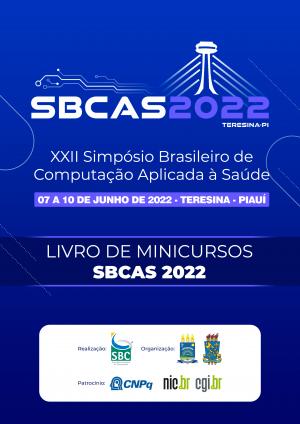Minicursos do XXII Simpósio Brasileiro de Computação Aplicada à Saúde
Palavras-chave:
SBCAS 2022, Minicursos do SBCAS 2022, Computação Aplicada à SaúdeSinopse
O Livro de Minicursos do SBCAS 2022 aborda temas de interesse para a comunidade de Informática na Saúde. Estes temas vão de fenótipos na pesquisa observacional, passando por IoT e Modelagem com foco em pacientes, além de Terapias Multissensoriais, Tecnologias para prestação de cuidados de saúde e terminando em aplicações de classificação de COVID-19 em imagens.
O primeiro capítulo, chamado “Internet das Coisas de Saúde: aplicando IoT, interoperabilidade e aprendizado de máquina com foco no paciente” apresenta a teoria e a evolução dos sistemas de saúde, para ao final discutir possíveis soluções para o desenvolvimento de um modelo distribuído de interoperabilidade de informações.
O capítulo “Robôs Socialmente Assistivos: Desenvolvendo Sessões de Terapia Multissensorial com o Robô EVA” apresenta a teoria de Robôs Socialmente Assistivos e descreve a arquitetura (hardware e software) do robô EVA que é uma plataforma open-source para terapias de pacientes com Alzheimer e para crianças com Transtorno do Espectro Autista.
No terceiro capítulo cujo o título é “Modelagem, Mineração e Análise de Jornadas/Trajetórias de Pacientes” são apresentadas técnicas de mineração de dados na sequência de atendimentos e procedimentos realizados pelo paciente, com isso um novo campo de pesquisa é trabalhado.
O capítulo “Classificação e Segmentação de COVID-19 em Imagens de Tomografia Computadorizada Usando Aprendizado Profundo” apresenta técnicas de auxílio ao diagnóstico de COVID-19 para exames de tomografia computadorizada.
O penúltimo capítulo “Sistema Mystrengths+Myhealth (MSMH): Tecnologia auxiliar para prestação de cuidados de saúde” tem como tema o conceito de saúde “whole-person” que é multidimensional e complexo, com diversos elementos que influenciam o indivíduo sendo necessário a integração desses elementos na prestação de cuidados de saúde.
Por fim, o último capítulo “Fenótipos no contexto da pesquisa observacional: OHDSI Phenotype Phebruary 2022” mostra que os fenótipos são os elementos fundamentais das análises e a ligação com os dados padronizados de modelos, apresentando o resultado da criação de uma rede colaborativa, seus conceitos, influência na geração das coortes e validação de resultados.
Capítulos
-
1. Internet das Coisas de Saúde: aplicando IoT, interoperabilidade e aprendizado de máquina com foco no paciente
-
2. Robôs Socialmente Assistivos: Desenvolvendo Sessões de Terapia Multissensorial com o Robô EVA
-
3. Modelagem, Mineração e Análise de Jornadas / Trajetórias de Pacientes
-
4. Classificação e Segmentação de COVID-19 em Imagens de Tomografia Computadorizada Usando Aprendizado Profundo
-
5. Sistema Mystrengths+Myhealth (MSMH): Tecnologia auxiliar para prestação de cuidados de saúde
-
6. Fenótipos no contexto da pesquisa observacional: OHDSI Phenotype Phebruary 2022
Downloads



